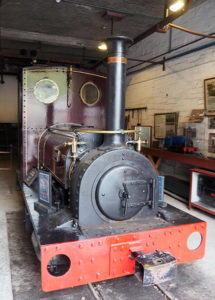The rapid development of towns during the Industrial Revolution led to to an enormous demand for slate for roofs of houses and factories. Welsh Slate was highly prized as the best as it was very durable and split easily.
Commercial quarrying began at Dinorwic in the early C19th and by the end of the century, employed over 3000 men producing 1700 tons of slate a week.
Slate was brought down to workshops built on flat land at the head of Llyn Padarn, created by tipping of slate waste. Over 100 men worked here. As well as splitting and trimming slate, the workshops also carried out all the repair and maintenance work demanded by a quarry, with blacksmiths forge, pattern making loft, foundry to produce machinery parts and tools, steam locomotive workshops and even a saw mill to cut timber beams.
The workshops were built as a square around a central “courtyard,”:http://www.geograph.org.uk/photo/294353 with the waterwheel house behind. Above the main entrance is the clock, which was probably installed around the mid 1890s. This acted as a timekeeper for the workshops, trains taking slate to Port Dinorwic, and controlling blasting times at the quarry face. It was also the timekeeper for the local community with a bell that could be heard by everyone living in Llanberis.
The living quarters of the Chief Engineer were on one side of the main gateway, indicating his status and importance.
The workshops were powered by water brought down in cast iron pipes from the slopes of Snowdon. The waterwheel was constructed in 1870 by de Winton of Caernarfon and with a diameter of just over 50’ was the largest working waterwheel in mainland Britain. This was sited in a brick casing and reached by an external stair. A turning axle run through the workshops with belt drives off it. It was used until 1925 when the iron work was beginning to show signs of fatigue. A smaller and more efficient Pelton wheel replaced it.
Quarrying was a very dangerous occupation and there was a high accident rate with broken bones, lost fingers, crush injuries and even death. A hospital was built in 1860, on the hillside above Llyn Padarn and a short distance from the workshops. It was largely maintained by the men’s own contributions to a Sick Club. The club provided free medical care, a weekly payment during absence from work through sickness or injury, a small payment on retirement and burial expenses. It had its own operating theatre for procedures such as amputation and was one of the first hospitals in Britain to have an X-ray machine. Having a hospital close to the quarry allowed workers to get back to work with minimal delay after receiving treatment.
General surgery was carried out here until the 1940s when it was downgraded to a first aid centre and was finally closed in 1962.
When the quarries closed in 1969, the workshops were left abandoned with much of the original equipment and tools. The site was opened as a museum a few years later, with examples of cranes and wagons in the courtyard. Una in the loco shed, is a narrow gauge steam locomotive built in 1905 by the Hunslet Engine Company for the nearby Pen Yr Orsedd quarry and is similar to locos used at Dinorwic. The original “waterwheel”:http://www.tripadvisor.co.za/LocationPhotoDirectLink-g186448-d295848-i264447124-National_Slate_Museum-Llanberis_Snowdonia_National_Park_North_Wales_Wales.html has been restored and is still turning.
The quarry hospital was reopened as part of the museum and a ward and operating theatre have been restored to their late C19th state. The x ray machine is still there.
One of the rooms in the courtyard has been set up as a caban, where the men gathered to eat and socialise. It is sparsely furnished with trestle tables and benches. There was a strict hierarchy and apprentices sitting further from the fire.
The small terrace of quarryman’s houses near the waterwheel were brought here from Tanygrisiau.
This is a fascinating museum. I first visited a few years after it opened and was impressed. Thirty years on, it is as good as ever. There are videos to watch, lots of old photographs, and a “demonstration “:http://museum.wales/slate/whatson/3855/Slate-Splitting-Demonstrations/ of slate splitting. I’ve written a series of more detailed reviews for the different parts of the museum.
The houses show living conditions from the mic C19th to when the quarries closed. There are lots of information boards around the site as well as a cafe and shop. Best of all, it is free! it is open 10-5 from Easter- October. November to Easter it is open 10-4 but closed on Saturdays.
Check opening times for the Quarry Hospital at the Museum as it was only open weekend afternoons in October… There doesn’t seem to be any times on on the web either.
“Website”:https://museum.wales/slate/










